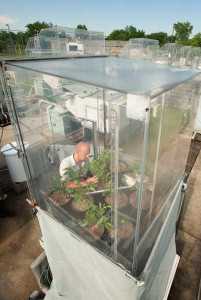Potatoes Could Step Up Performance Under Climate Change Pressure
Studies to measure how potato plants would respond to elevated atmospheric carbon dioxide levels and the increasingly erratic rainfall patterns expected to result from global climate change have been conducted by USDA’s Agricultural Research Service (ARS) agricultural engineer David Fleisher and his colleagues.

Agricultural engineer David Fleisher studies water-stressed potato plants in a soil-plant-atmosphere research chamber that controls carbon dioxide and irrigation levels. Results from the study reveal how climate change affects potato plant growth. Photo by Stephen Ausmus, USDA.
The team conducted two outdoor chamber studies to evaluate effects of short-term drought cycles at current and elevated carbon dioxide levels. The studies were conducted using soil-plant-atmosphere research chambers that provided precise control over carbon dioxide levels, air temperature, irrigation and humidity. The chambers contained sensors that monitored air, soil, and canopy temperatures, relative humidity, and solar radiation above and below the canopy.
The quantity of solar radiation in the first study was about twice as much as in the second. Having two different study periods allowed the scientists to evaluate how variations in solar radiation during the drought periods affected plant response. In both studies, 11-day drought cycles were applied before tuber formation began and around 10 days after tuber formation began.
The researchers observed significant differences in plant response that they attributed to the variation in solar radiation, which, in turn, affected plant water-use efficiency and dry matter production. With all other growth factors being equal, the plants in the first study had a 30% to 200% increase in total dry matter production, depending on carbon dioxide levels and water availability.
The team also noted that the cyclic droughts resulted in lower levels of dry matter and leaf area production. They concluded that drought stress before tuber formation probably enhanced the future delivery of carbon, water, and plant nutrients to tubers instead of to stems or leaves — and that this response increased under elevated carbon dioxide levels.
Averaged across all drought treatments, tuber yield from plants growing under elevated carbon dioxide levels was as much as 60% greater than tuber yield from plants growing under current carbon dioxide levels.
Fleisher, who works at the ARS Crop Systems and Global Change Laboratory in Beltsville, MD, published the study results in Agricultural and Forest Meteorology.
Source: USDA ARS press release.









